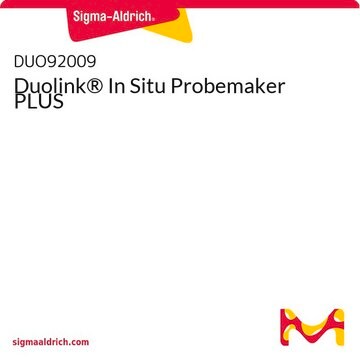Incubation in the pre-heated Heat Transfer Block increases staining efficiency and reproducibility between different plates and reduces plate edge effects. Other incubation methods can be utilized, but potentially to the detriment of reproducibility and increased plate edge effects.
추천 제품
제품 라인
Duolink®
기술
proximity ligation assay: suitable
적합성
suitable for brightfield
suitable for fluorescence
저장 온도
20-25°C
일반 설명
애플리케이션
This product can be applied to both the Duolink® In Situ Fluorescence Protocol and the Duolink® In Situ Brightfield Protocol depending on the detection reagents used.
Visit our Duolink® PLA Resource Center for information on how to run a Duolink® experiment, applications, troubleshooting, and more.
To perform a complete Duolink® PLA in situ experiment you will need two primary antibodies (PLA, IHC, ICC or IF validated) that recognize two target epitopes. Other necessary reagents include a pair of PLA probes from different species (one PLUS and one MINUS), detection reagents, wash buffers, and mounting medium. Note that the primary antibodies must come from the same species as the Duolink® PLA probes. Analysis is carried out using standard immunofluorescence assay equipment.HRP is also available for brightfield detection.
Duolink® In Situ Microplate Heat Transfer Block will increase staining efficiency and reproducibility between different plates and reduce edge effects when using Duolink® reagents in microtiter plates.
Keep the Heat Transfer Block preheated at 37°C and keep it in the 37°C incubator throughout the whole Duolink® In Situ protocol. Place the microtiter plate in the Heat Transfer Block during incubation steps.
Application Note
Two primary antibodies raised in different species are needed. Test your primary antibodies (IgG-class, mono- or polyclonal) in a standard immunofluorescence (IF), immunohistochemistry (IHC), or immunocytochemistry (ICC) assay to determine the optimal fixation, blocking, and titer conditions. Duolink® in situ reagents are suitable for use on fixed cells, cytospin cells, cells grown on slide, formalin-fixed, paraffin embedded (FFPE), or tissue (fresh or frozen). No minimum number of cells is required.
Linkage
Let us do the work for you, learn more about our Custom Service Program to accelerate your Duolink® projects
View full Duolink® product list
특징 및 장점
- No overexpression or genetic manipulation required
- High specificity (fewer false positives)
- Single molecule sensitivity due to rolling circle amplification
- Relative quantification possible
- No special equipment needed
- Quicker and simpler than FRET
- Increased accuracy compared to co-IP
- Publication-ready results
제조 메모
법적 정보
가장 최신 버전 중 하나를 선택하세요:
이미 열람한 고객
문서
Support information including tips and tricks, frequently asked questions, and basic troubleshooting.
Things to consider for preparation, setup and execution of the Duolink® assay protocol
관련 콘텐츠
Applications to detect, quantify and visualize protein-protein interactions, post-translational modifications and low expression protein detection using proximity ligation assay
활성 필터
자사의 과학자팀은 생명 과학, 재료 과학, 화학 합성, 크로마토그래피, 분석 및 기타 많은 영역을 포함한 모든 과학 분야에 경험이 있습니다..
고객지원팀으로 연락바랍니다.












